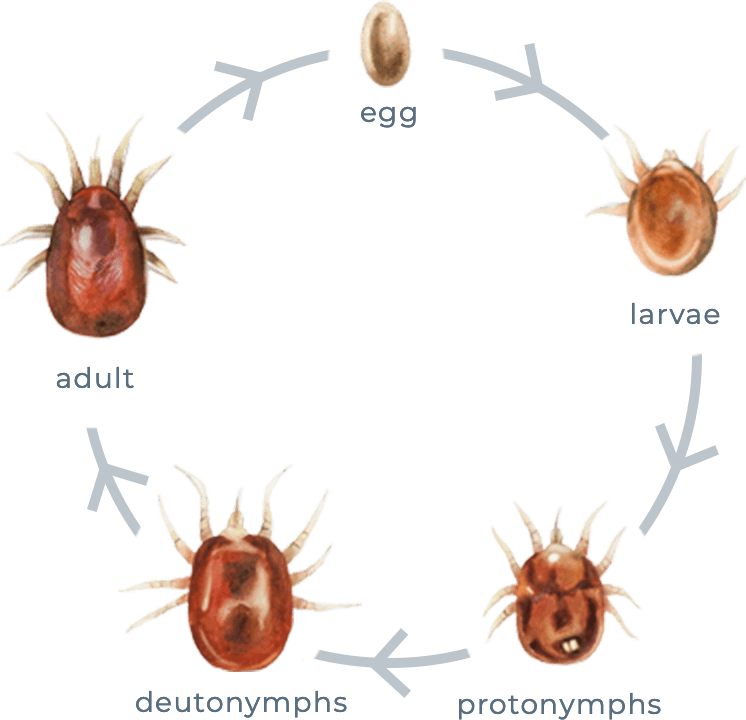Symptoms
First symptoms you might notice are that your birds are „tap dancing” in the loft at night – it is because of the red mites. You can hear their feet tapping. When you enter the loft with a flashlight, you will observe the birds stamping first one and then the other foot, sometimes pecking at their feet as if something is irritating them.
General symptoms are:
- Restlessness
- Excessive grooming
- Ruffling of feathers
- Skin irritation
- In some cases, feather damage is evident
Hefty infestations can cause anaemia and might even result in the death of squabs. Blood – sucking lice may also transmit poxvirus and harboring western and eastern encephalitis viruses as they will feed on more than one pigeon.
In general infested pigeons appear unthrifty and pale from the blood-sucking mites, because mites cause constant irritation and unrest.
Live cycle

Mites have four stages in their life cycle: egg, larva, nymph and adult. Six-legged larval mites hatch from eggs after a period of incubation. After a full meal, parasitic animal and bird mites molt and transform into nymphs with eight legs. Following a second feeding and one or more molts, the adult develops. The life cycle requires up to one week for completion. Adults can survive off the host for 3-4 weeks (Loomis 1984)
Transmission
Infested birds of all types are the carriers. When birds are housed or transported in close contact with each other, mites readily transfer from one host to another. Indirect transmission by recently contaminated equipment and supplies may also introduce mites to a loft.
Red Mites live in the cracks and crevices all around the pigeon loft. They only move on to pigeons for the duration of the evening and night to suck blood. These mites can easily go undetected during the day.
Diagnosis of Red Mites in Pigeons
Visual inspection of the feathers of pigeons will reveal the mites on the feathers or on the skin. Placing of traps (e.g. balls of cotton wool) nests in the evening and removing them in the morning will reveal the presence of red mites.

To appropriately check for a possible red mite infestation, balls of cotton wool should be positioned in the nesting bowls and on perches, collected in the morning and then inspected for the common small red mites which tend to hide within the cotton balls.
Red Mite Loft Control and Treatment
Depending on the severity of the infestation, red mites can be notoriously difficult to eradicate. Because they do not live on the birds but around and about the loft, every crack and crevice need to be treated with Dergall. New birds or birds returning from shows or races should not be admitted to the loft unless they are treated for mites. Loft and litter sprays are helpful.
The usual process will involve spraying the loft with Dergall in the presence of birds. Pigeons can be left in the loft during the application but be sure to follow the treatment recommendations.
It is important to note that treating the loft once is not enough to clear a heavy infestation. The process must be repeated at least every 3-4 weeks to prevent the mites from reinfesting. It is recommended to monitor infestation using the cotton trap method described above.
